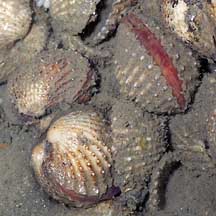 |
|
|
'See-hum'
Anadara sp.
Family Arcidae
updated May 2020
if you
learn only 3 things about them ...
 It is an ingredient in laksa and char kuay teow, favourite
local dishes. It is an ingredient in laksa and char kuay teow, favourite
local dishes.
 Its body is red because it has haemoglobin just like us. Its body is red because it has haemoglobin just like us.
 It
can cause cholera, hepatitis A and food poisoning. It
can cause cholera, hepatitis A and food poisoning. |
|
Where seen? This robust little clam is still commonly seen
on some parts of our Northern shores, particularly on silty sand. 'See-hum'
is what locals call it. They are now no longer as common as they
used to be in the past. Those sold in our markets and restaurants
come mostly from Malaysia.
Features: 3-4cm. The two-part
shell is heavy, and may be quite spherical. The surface is ribbed
with small, rounded beads on the ribs. The
animal's body is usually orange or reddish. So
it is sometimes also called the Blood cockle. This is due to the presence of haemoglobin, the same substance that
colours our own blood red too. Haemoglobin assists in transporting
oxygen within the body and may help the clams live in the oxygen-poor
habitats.
Living in a clam: The tiny Pea crab (Pinnotheres sp.) is sometimes found living
inside these bivalves. The
crab not only gains shelter but also eats some of the food gathered
by the host clam. |

Changi, Jun
05 |
|

Seletar, Jun 02 |

Tanah Merah, Apr 05 |
| Human
uses: 'See-hum' is relished in many local favourites
such as char kway teow and laksa. However, they may be affected
by red tide
and other harmful algal blooms. They are also linked to
cholera, hepatitis A and dysenteric shellfish poisoning. 'See-ham'
is farmed in some places for sale as seafood. In Malaysia, it is a major mollusc that is marketed with an
annual catch exceeding 75,000 metric tons. |
| 'See-ham'
on Singapore shores |
Links
References
- Tan Siong
Kiat and Henrietta P. M. Woo, 2010 Preliminary
Checklist of The Molluscs of Singapore (pdf), Raffles
Museum of Biodiversity Research, National University of Singapore.
- Tan, K. S.
& L. M. Chou, 2000. A
Guide to the Common Seashells of Singapore. Singapore
Science Centre. 160 pp.
- Abbott, R.
Tucker, 1991. Seashells
of South East Asia.
Graham Brash, Singapore. 145 pp.
|
|
|



